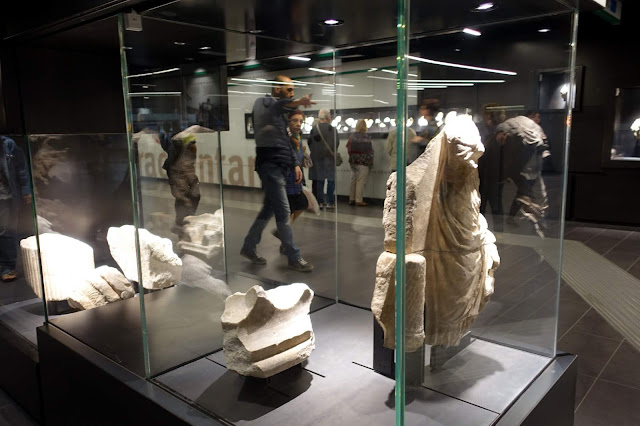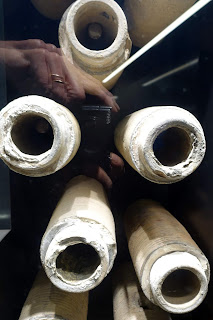Rome Travel Guide
Rome Architecture, History, Art, Museums, Galleries, Fashion, Music, Photos, Walking and Hiking Itineraries, Neighborhoods, News and Social Commentary, Politics, Things to Do in Rome and Environs. Over 900 posts
Thursday, July 26, 2018
"Love Nests"/Exploitation in the Woods: Rome Prostitution
Get a few miles outside Rome's center, on any of a hundred country roads, and you'll see young ladies in very short shorts, trolling for business. Sometimes there's a couch where the work gets done. In this case, the love - or sex - bed, which admittedly seems a bit too close to the traffic for privacy, has been covered with wide strips of blue fabric.
These photos were taken on via di Castel di Guido, between the town of Castel di Guido and via Aurelia, west of Rome. A few hundred yards down the road, we found the women who might have made use of this spot, soliciting motorists as they came off the eastbound exit ramp.
We probably see more evidence of prostitutes than most Romans, since we are often hiking near these only-barely-remote spots. We've chatted with some of these women, but not about their jobs. They've offered to - and have - protected our scooter while we go exploring.
The issue of prostitution in Italy is a difficult one.
The European Union categorizes prostitution as completely legal in Italy and other European states, including Spain, Portugal and the UK. But it’s street prostitution that’s legal in Italy. Brothels are not. The 1958 Merlin law (named for Lina Merlin, the first woman elected to Italy’s Senate) banned brothels (known as case di tolleranza, "houses of tolerance") and imposed a new offense, “exploitation of prostitution,” aimed at pimps and clients.
In Italy, police use laws based on obscenity, including dressing in revealing and suggestive clothing, to move prostitutes out of an area or neighborhood. Current Italian law punishes obscene acts committed in the vicinity of places frequented by children and young people. According to a Rome prosecutor, these are parks, schools, day-care centers and athletic facilities. The result is women who ply their trade on the roadsides we frequent - far from the city center.
In Italy immigrant sex workers are a particularly vulnerable group. The International Organization for Migration estimated that 80 percent of the 11,000 Nigerian women who entered Sicily in 2016 would end up trafficked into the sex trade. These women — as well as undocumented women in the U.S. sex trade — face deportation if they attempt to report their circumstances.
There's more discussion of the pros and cons of legalization of prostitution in Dianne's article in TheAmerican/inItalia.
Bill and Dianne
Thursday, July 19, 2018
Rome's New Metro "Archaeological Station" - "Archeo-Stazione" - its newest and best free museum
 |
| Travelers in the San Giovanni metro station amidst artifacts from ancient Rome. |
 |
| Under this very ordinary Metro entrance lies an incredible museum. |
 |
| Artifacts discovered under the station at this level (more photos below). |
 |
| A 1st-century BC plumbing system (more photos at the end of the post) |
The station, which opened May 18, has been an enormous hit primarily with Romans. It may take time for tourists to catch onto this - in reality - marvelous free or low-cost museum.
 |
| A central hub - travelers going through the station, and video displays on the right. |
Dianne
 |
| The escalator going to the bottom level takes one down through time. On the right it says "Republican age" and then "Proto-historic age." |
 |
| The lowest level does not have artifacts, but has pictures on the walls of the kind of life that existed on earth (in Rome) at this level of feet below the current level of Rome. |
 |
| A Roman delighting in her 'find.' |
 |
| Pipes from the 1st century BC plumbing system (and Bill's hand and camera reflecting in the glass) |
 |
| The discovery of broken amphorae used to create a pipe in the plumbing system. |
 |
| An end piece from the side of a Roman house. |
 |
| Amphorae |
 |
| Amazingly enough, the remains of a wooden basket-- 1st-2nd century BC. |
Thursday, July 12, 2018
Hiking: Tivoli to San Polo, 10 miles, 2300 feet, great views
| Monte Cattillo, seen from the Tivoli bar, with requisite beer, after the hike. |
| Benches line the right side of the street in San Polo. |
| Bar Centrale. Quiet, but open, on a Sunday afternoon. |
Or you could buy lunch at Bar Centrale.
Or, from San Polo, you could go on to Monte Gennaro - another 6 hours or so! We've climbed Gennaro half a dozen times, from several directions, but never from this one. Tivoli and San Polo are in the Lucreteli, and Monte Gennaro is the highest mountain outside Rome. The Tivoli to San Polo hike gives you the flavor of the Lucretili and some small town and farm ambience as well.
The ritorno (return) is a reversal of the andato (no good translation, sort of "going" or "the way there"): down from San Polo, steep climb up a hot road to the ridge, more or less flat journey along the mostly open ridge (great views on both sides, especially left), descent through the oaks, the scrub, and along the shoulder of Monte Catillo and down into Tivoli.
There used to be a lot of cows in these pastures, and bathtubs were used as rural fontane (fountains) to provide the animals with water.
| Dianne at the oak grove, on the descent. Several years ago, during a drought, we feared the oaks might die. Today, they appear healthy. Red and white trail marker on the tree. A clear path. |
| Descent into Tivoli. The white triangle just below the horizon and about 2/3 of the way toward the right side of the frame, is Santiago Calatrava's famous, but unfinished and unused, swimming pool. |
| A short section of road at the beginning and end of the hike. |
| The numbers are hours and minutes estimated to reach the destination, not distance. |
| Grateful for the shade. |
Then, about halfway to San Polo, be careful to avoid pitching downward to the left (that's another trail, and a shorter hike) and stay more or less on the ridge. There are some lovely and cool shaded stretches.
The total dislivello (elevation gain) is about 2300 feet (total for both directions, which involve ups and downs both ways). That means this one's for hikers, not walkers. Lots of rocky paths, so hiking boots are highly recommended. There's water at the Tivoli train station (look for the eagle fountain at one end) and at the fountain in San Polo's main square--but none on the trail, with one exception that's quite close to San Polo.
described another hike from the Tivoli station to the higher Monte Sterparo in 2016. That blog post includes some photos of our "cow map" that has part of this hike on it as well.
We've been partial to Tivoli for a long time, not only for hiking, but also for just the feel of this small, very old town (dating from the ancient Romans), the magnificent 19th-century Villa Gregoriana (#6 on the RST Top 40) and the more famous 16th century Villa d'Este with its fountains (the wild and the ordered, respectively, were compared in Rome the Second Time).
Bill
Friday, July 6, 2018
Caffe' Natalizi
| via Po. At right, what was our coffee bar a year ago, now being remodeled for a dress shop. |
It's both a coffee bar and a pasticceria (bakery), which means that the cornetti (croissant, brioche, sweet rolls, pastries) are fresh and, in this case, extraordinary--not only warm and delicious but large enough that we could purchase only one and divide it (with the spoon that always comes with coffee). On the saucer was a piece of wrapped chocolate.
| Not a lot of counter space, and the place could get very crowded. But service was excellent, and most Italians drink and go. |
After about a week, the woman at the cassa (cash register, where you place your order and pay) knew the order and said simply, "il solito?" (the usual?) and a barista would begin making our American coffees when we walked in the door.
It's customary to place your receipt (scontrino) on the bar with a tip (mancia) of 10 centesimi (12 cents) for each coffee, and we did that.
Outside, every day, a black man, likely Nigerian, and not necessarily the same man every day, held out a cap, asking for money (the man at the right of the photo at the top). We usually gave him 50 centesimi (about 60 cents) on our way out. Because immigrants without their legal status (usually waiting for their legal status to be determined) are not allowed to work for wages, some beg in front of bars and grocery stores or, along via Po and many other Rome streets, sweep a portion of the sidewalk while soliciting contributions. The woman in the top photo has just exited the bar and is giving the man some change.
Bill
Subscribe to:
Posts (Atom)

